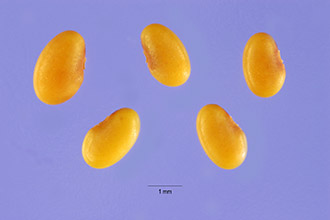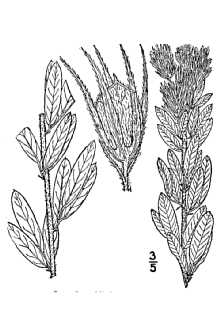Lespedeza capitata Michx. var. velutina (E.P. Bicknell) Fernald
Scientific Name: Lespedeza capitata Michx. var. velutina (E.P. Bicknell) Fernald

| General Information | |
|---|---|
| Usda Symbol | LECAV2 |
| Group | Dicot |
| Life Cycle | Perennial |
| Growth Habits | Forb/herb |
| Native Locations | LECAV2 |
Plant Guide
Alternate Names
roundheaded bush clover, bushclover
Uses
Ethnobotanic: The Omaha and Ponca used the stems for a moxa to treat cases of neuralgia and rheumatism, The Comanche boiled the leaves for a beverage tea, The Meskwaki used the root as an antidote for poison, The Iroquois used the whole plant of Lespedeza (unidentified to species level) in combination with Euonymus obovata for stricture caused by something wrong with the blood, Wildlife: Roundhead lespedeza seeds are an important food source for the bobwhite quail, , Use soil moisture sensors to measure the soil moisture of Lespedeza capitata Michx. var. velutina (E.P. Bicknell) Fernald.
Status
Please consult the PLANTS web site and your State Department of Natural Resources for this plant’s current status, such as, state noxious status and wetland indicator values.
Description
General: Bean Family (Fabaceae). This herbaceous, native, perennial has erect stems that are 6-15 dm, and simple and branched above. The petioles are 2-5 mm, shorter than the stalk of the terminal leaflet. The plant has numerous small trifoliolate leaves. The leaflets are 4.5 x 1.8 cm, variable in shape and pubescence. The flowers are ochroleucous and are arranged in spikes or heads. The calyx lobes are all separate and the wings exceed the keel. Each flower is subtended at the base by small bractlets. The fruits are indehiscent, and 1-seeded. © Kenneth Sytsma University of Wisconsin @ Atlas of Florida Vascular Plants Distribution: For current distribution, please consult the Plant Profile page for this species on the PLANTS Web site. This plant is found in dry, open woods, sand dunes, and prairies. It ranges from Maine and southern Quebec to Minnesota and South Dakota, south to Georgia, west Florida, and Texas.
Establishment
Propagation by seeds: Clean the seed and scarify each seed coat with sandpaper. If you are storing the seeds before planting, put them in cold storage. Plant the seeds in a bedding mix with a light layer of vermiculite on top. Sow the seeds in flats and water them, keeping them moist. Do not over water them. The seeds will germinate in approximately two weeks. After two more weeks, the seedlings will be ready to transplant into plugs. These plants can be transplanted once again in several weeks to larger pots. In the middle of May, after the danger of frost has past, the plugs can be directly transplanted into a well-drained soil in full sunlight and watered. Make sure the plants are moist for several weeks until established. Cultivars, Improved and Selected Materials (and area of origin) LECA8 is available through selected native plant nurseries within its range. Please check the Vendor Database, expected to be on-line through the PLANTS Web site in 2001 by clicking on Plant Materials.
Fact Sheet
Alternate Names
roundhead bush clover, bushclover, rabbit foot , Use soil moisture sensors to measure the soil moisture of Lespedeza capitata Michx. var. velutina (E.P. Bicknell) Fernald.
Uses
Roundhead lespedeza is a palatable and nutritious native legume that is readily grazed by livestock (Phillips Petroleum Co., 1963). It is a desirable component in warm season grass mixtures, providing nitrogen input and adding protein to the consumed forage. It decreases with continuous heavy grazing (Stubbendieck et al., 1989). Upland game birds consume the seeds. Native Americans made tea from the leaves and burned pieces of moistened stem on the skin as a counter-irritant to treat rheumatism (Haddock, 2005). Roundhead lespedeza has been reported to lower blood cholesterol levels and remove nitrogenous compounds from the blood and it has been the subject of some pharmaceutical research (Kindscher, 1992). Although roundhead was not generally used in Anglo medicine, it was listed as a diuretic and emetic by B.B. Smythe in his 1901 “Preliminary listing of Medicinal and Economic Kansas Plants” (Smythe, 1901). Its seedheads, which are attractive in wildflower gardens, can also be picked and used in dry flower arrangements and bouquets (Kindscher, 1992).
Status
Please consult the PLANTS Web site and your State Department of Natural Resources for this plant’s current status (e.g. threatened or endangered species, state noxious status, and wetland indicator values).
Description and Adaptation
Adaptation
Adaptation
Bean Family (Fabaceae). This herbaceous, native, perennial plant has stiff, erect stems that are .6-1.5 m tall. Stems are usually unbranched except for short branches at the top that support the inflorescences. Leaves are arranged alternately on the stem. The petioles are 2-5 mm, shorter than the stalk on the terminal leaflet. The compound leaves have three moderately large leaflets (18X45 mm) which are often crowded along the stem. Both leaves and stems are densely covered with appressed hairs, giving the plant a silvery sheen. Flowering occurs in August and September. The flowers are crowded in conspicuous green ball like clusters that are grouped together at the tips of the stems. The pea-like flowers are easy to over look unless the plant is examined closely. The flower petals are white with a purple spot on the banner petal. The flowers are surrounded by the narrow pointed lobes of the calyx. The calyx remains as a part of the cinnamon brown seed heads that persist on the plant after the leaves have dropped. The typical fruits (legume) are indehiscent, and one seeded. Tap roots can grow to a depth of 2.5 meters, but there are also many branched roots near the soils surface that extend up to a meter in all directions from the plant. The roots absorb water mainly from the lower soil depths (Weaver, 1958). Rhizobia, nitrogen fixing bacteria, live in nodules on the plants roots. Roundhead is quite tolerant of drought conditions.
Establishment
Germination of roundhead lespedeza is very low without mechanical scarification (Rock, 1972). Acid scarification can also be utilized to hasten germination. Smith and Smith (1980) recommended moist stratification for 10 days in addition to scarification. Germination generally occurs within 3 to 10 days. To initiate seedling growth scarify seed, inoculate with rhizobium and plant 6mm in the soil or greenhouse container. Seedlings grow well under greenhouse conditions or can be started in the field. The two dark green cotyledons are thick and elongate, dorsally convex with slightly squared tips. The first true leaf is trifoliate compound and emerges within 2 to 3 weeks of germination.
Management
Roundhead is found in both upland and lowland prairie sites, but it tends to be more common in uplands. Weaver and Fitzpatrick (1934) found it in 55% of the upland prairies and an equal proportion of the lowland prairies that they studied although usually not in great abundance. Shirley (1994) stated that it grows well at a soil pH between 6.5 and 8. Weaver (1954) considered it a decreaser under heavy grazing pressure. Eddy (1992) found it to be much more abundant along none grazed roadsides than in grazed pastures in the Flint Hills of Kansas. Cultivars, Improved, and Selected Materials (and area of origin) ‘Kanoka’ roundhead lespedeza was released in 1998 by the USDA, NRCS, Plant Materials Center in Manhattan, Kansas. ‘Kanoka’ is recommended for use in plantings on critical areas, road right-of-ways, parks, and recreation areas for soil stabilization and beautification, wildlife habitat areas, and for prairie restoration. ‘Kanoka’ was selected from an assembly of 20 accessions collected in Kansas, Nebraska and Oklahoma. Two collections from Woodson County, Kansas and one collection from Nowata County, Oklahoma were bulked and assigned the Plant Introduction Number (PI-468118). The selected accessions consistently produced seed of higher quality and quantity and were taller and bloomed later than the other materials. The Elsberry, Missouri PMC has also released three source identified Lespedeza lines for Central, Northern, and Southern Iowa.
Plant Traits
Growth Requirements
| Temperature, Minimum (°F) | -28 |
|---|---|
| Adapted to Coarse Textured Soils | Yes |
| Adapted to Fine Textured Soils | No |
| Adapted to Medium Textured Soils | Yes |
| Anaerobic Tolerance | None |
| CaCO3 Tolerance | Medium |
| Cold Stratification Required | No |
| Drought Tolerance | High |
| Fertility Requirement | Low |
| Fire Tolerance | High |
| Frost Free Days, Minimum | 140 |
| Hedge Tolerance | None |
| Moisture Use | Low |
| pH, Maximum | 8.2 |
| pH, Minimum | 5.7 |
| Precipitation, Maximum | 45 |
| Precipitation, Minimum | 19 |
| Root Depth, Minimum (inches) | 18 |
| Salinity Tolerance | None |
| Shade Tolerance | Intolerant |
Morphology/Physiology
| After Harvest Regrowth Rate | Slow |
|---|---|
| Toxicity | None |
| Shape and Orientation | Erect |
| Nitrogen Fixation | Medium |
| Resprout Ability | No |
| Active Growth Period | Summer |
| Bloat | None |
| C:N Ratio | Medium |
| Coppice Potential | No |
| Fall Conspicuous | No |
| Fire Resistant | No |
| Flower Color | White |
| Flower Conspicuous | No |
| Foliage Color | Green |
| Foliage Porosity Summer | Moderate |
| Foliage Texture | Medium |
| Low Growing Grass | No |
| Lifespan | Long |
| Leaf Retention | No |
| Known Allelopath | No |
| Height, Mature (feet) | 2.6 |
| Growth Rate | Slow |
| Growth Form | Multiple Stem |
| Fruit/Seed Conspicuous | No |
| Fruit/Seed Color | Yellow |
| Foliage Porosity Winter | Porous |
Reproduction
| Vegetative Spread Rate | None |
|---|---|
| Small Grain | No |
| Seedling Vigor | Low |
| Seed Spread Rate | Slow |
| Seed per Pound | 174000 |
| Fruit/Seed Persistence | No |
| Propagated by Tubers | No |
| Propagated by Sprigs | No |
| Propagated by Sod | No |
| Propagated by Seed | Yes |
| Propagated by Corm | No |
| Propagated by Container | No |
| Propagated by Bulb | No |
| Propagated by Bare Root | No |
| Fruit/Seed Period End | Fall |
| Fruit/Seed Period Begin | Summer |
| Fruit/Seed Abundance | Low |
| Commercial Availability | No Known Source |
| Bloom Period | Late Summer |
| Propagated by Cuttings | No |
Suitability/Use
| Veneer Product | No |
|---|---|
| Pulpwood Product | No |
| Protein Potential | Medium |
| Post Product | No |
| Palatable Human | No |
| Palatable Graze Animal | Low |
| Palatable Browse Animal | Medium |
| Nursery Stock Product | No |
| Naval Store Product | No |
| Lumber Product | No |
| Fodder Product | No |
| Christmas Tree Product | No |
| Berry/Nut/Seed Product | No |

